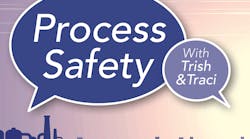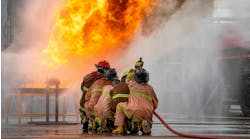Transcript
Traci: Welcome to "Process Safety with Trish & Traci," the podcast that aims to share insights from past incidents to help avoid future events. I'm Traci Purdum, executive digital editor with Chemical Processing. And as always, I'm joined by Trish Kerin, the director of the IChemE Safety Centre.
Welcome, Trish and you were just at the Global Congress on Process Safety, hoping you can give us a little bit of an update and insight of what you learned from that event.
Trish: Hi, Traci. Yeah, well, so I'm just back from traveling over to the U.S. So first major trip since COVID struck, a lot of learnings from the perspective of how to travel safely during COVID, especially when you've got 15/16-hour flights. So that was interesting, masked up the whole way. Making sure that we took all the reasonably practicable controls in place that we could to try and prevent catching COVID during transit, or indeed at the Congress as well. It was fantastic to see people again, face to face. And, you know, hats off to AIChE and CCPS, for delivering an amazing spring meeting, and GCPS. You know, against the odds, they've managed to pull it together during times of still a lot of COVID transmission. So certainly hats off to them for a fantastic event.
There was also some really interesting papers on cybersecurity and what we need to be doing to make sure our plants remain safe from potential attacks so that we don't see incidents resulting there, as well as Natech. So digging into those natural hazards triggering technological disasters, making sure that we can really get a handle on how to effectively design for and respond to hurricanes, tornadoes, earthquakes, tsunamis, etc. These are some of the sorts of things that are occurring and we're seeing significant incidents as a result. It was also fantastic to get some feedback on the podcast, Traci, so had a lot of people come up to me during the conference and say they listen to the podcast. So shout out to all the listeners out there that came to meet me last week in Texas.
Traci: That's awesome. We have fans.
Trish: Yes, it was. We have fans.
Traci: Well, that's awesome. And I'm glad to hear that you have some more fodder for cybersecurity and Natech, we do touch base on those. So we'll maybe touch base on those in the future too a little bit more. So a great response on that Congress there. Today's podcast, we're going to take a look back at the Chernobyl disaster, which is coming up on its 36-year anniversary, April 26. The brief assessment is the accident was the result of a flawed reactor design that was operated with ill-trained personnel. Can you give us a little bit more in-depth view of what happened there in 1986?
Trish: Yeah. You need to understand a little bit of history first. There are actually four reactors on the Chernobyl site. And the one that had the incident was reactor number Four. One and Two were built in the '70s. Three and Four were built in 1983. And so reactor Four was only three years old when this happened. There was also another two reactors being built at the same time. Chernobyl was quite a substantial size nuclear power generation site within that area at the time. But the design that they had was called the RBMK design, and there was a fundamental design flaw with how the fuel rods actually worked in the reactor itself. Now the biggest issue was that there was a concern around if the facility lost electricity, how long would the turbines continue to spin from the reactor to power the water coolant pumps to keep the reactor under control. And so, in reality, what was happening on the very day when Chernobyl had the incident, they were in the middle of doing a safety test. They were trying to do an experiment on the reactor to determine safety factors so they could make the right design improvements so that the reactors would be safe in the event of a power failure. They were actually trying to do the right thing at the time when it went wrong.
Now, there's issues with the RBMK design that led to some peculiarities that people didn't expect at the time. There was also issues with the training of the operators and knowing what they were doing. But interestingly, they were actually meant to do this experiment during the day on the 25th of April. But because there was so much demand on the power system that particular day, they were asked to hold it over and not do it until that night. And so that sort of partly started and had to stop. And then they started again, a little after midnight on the 26th of April and that's actually when things started to go wrong.
No worries! Subscribe and listen whenever, wherever.
Now one of the things we talk about in process safety is when you're doing higher risk activities you try and make sure you do them at the most appropriate time, usually the middle of the night or night shift would not be the most appropriate time to do something. Because inevitably, there are more challenges with working on night shift, there are fatigue-related aspects that can creep in. And so the fact that they ended up moving a test that was planned during the day, and doing it at night, may have also contributed to some of the response times and some of the issues that did occur and understanding some of the things that they were seeing because they weren't actually seeing what they expected in the data that they were receiving into the control room.
Eventually, as the reactor started to lose control, they had some ruptured fuel rods, and then they became, they jammed the control rods, so the control rods could no longer be put in to try and kill the reaction. There was a small overpressure, that led to a cracking open at the top of the reactor. And then there was a subsequent explosion, that was probably a result of hydrogen generation that occurred. And that then caused the major explosion that occurred. There were only two workers that were killed in those explosions. And if you look at the official fatality numbers, they're very, very low, I would suggest they're probably not accurate, because I don't think they take into account the people that were seriously impacted and died in the months and years after Chernobyl occurred, because as we know, it did release radioactive material across a wide area of Europe at the time. And it was actually originally detected... The Western world detected there was a problem when Sweden started to detect radioactive material. And so you know, Sweden is a long way from what is now Ukraine. And they were starting to detect the radioactive material and started to search back and say what's going on, where's this issue, we have radiation in the environment now, because at the time it was kept quiet. And there was attempts to hide the ramifications and hide the event in its entirety from the Western world.
Traci: That's kind of incredible in itself to hear that.
Trish: It is and it reflected, I think, a cultural issue at the time of, you know, believing that...not wanting to show that they weren't able to do what they needed to do, and able to run their nuclear power systems. There was a lot of nuclear reactors in the USSR at the time. And there're still, even in former USSR and obviously Russia today, there's a lot of nuclear reactors in that area. There were a lot of RMBK-designed reactors in that area as well. The designs have now changed and sort of moving forward a little bit, there has been a lot more cooperation after the accident between what was the East and the West in terms of nuclear technology to make sure that we don't ever see another Chernobyl again.
Traci: Now, you had mentioned a little bit about the...saying that they were supposed to do the test during the day, and did it at nighttime. And that might have led to a little bit of the reasoning. Is that something in lessons learned that people, facilities now maybe do all of their critical testing during the day?
Trish: I think in a lot of industries, we'd already learned that lesson. To be honest, long before this. So I don't think Chernobyl's incident happening at night really triggered that though we have seen other incidents that have occurred on nightshift. They weren't necessarily deliberate tests on systems but you know, if we think about Piper Alpha, the Piper Alpha incident was triggered at night, after a carryover from activities that were happening during the day. And then you know, a pump stripped out so they needed to put a pump back in service. They did that at night without understanding the ramifications of what was going on there.
We do see incidents occur at night. And I think in my experience in working in plants...and I wasn't working in plants in the '80s but I was in the '90s. We did always try and avoid doing anything particularly complex at night. We always tried to do anything that was complex during the day. Because during the day, we've got far more people to call on as resources, another set of eyes to look at it and say, "Oh, you're really sure about that?" Because at night, you're down to skeleton crew, you don't have all the engineers on-site, you don't have all the managers on-site. Some may argue the managers on-site may not be helpful at times. But you know, at the end of the day, another level of oversight can actually be quite helpful. And also someone to be able to prioritize and say no, stop doing that we need to focus on this. I think we'd had that lesson in a lot of industries before Chernobyl. I hope it's now a much stronger lesson since Chernobyl because it really is, you know...as I said, we always avoided doing anything complex at night if we could because everything was always a lot harder in the dark.
Traci: Five years ago, they completed the encapsulation of reactor 4. Can you talk about the engineering aspects that went into that and what has that achieved?
Trish: Yes. So that encapsulation project was one of the most amazing engineering feats of its time. At the time of the incident, they tried to cover it up and they did put a barrier over the top at the time. Because also keep in mind as I said, this was reactor 4. Most people don't realize reactors 1, 2, and 3 continued to operate on the Chernobyl site until the early 2000s. The area continues to be a nuclear reactor power station, even though reactor 4 was destroyed, and not appropriately encapsulated at the time. Now what they ended up doing was making a decision to erect what they call the new safe confinement structure, the NSC. And that was completed back in 2017. As I said, an amazing engineering feat, it's actually the largest movable land-based structure ever built. So if you imagine this enormous arch that sits over the reactor site, and effectively it was built on railway tracks and slid into place, so they built it at a safe position away from the radiation and then slid it into place. Now, it's about 110 meters high. So you know, really, really quite high. You think about how far the 100-meter dash is on a track, you know, 110 meters high, 165 meters long and spans 260 meters, it covers the original encapsulation as well as the reactor, so they deliberately left it covered while they moved this new one over.
And the idea of having this particular NSC in place, is that it has some robotic arms in it and has some cranes and things like that. So it can actually now, let us get to the point where reactor 4 can be dismantled and material removed and safely disposed of, without anybody being inside. They can actually operate this entire thing externally to be able to safely deal with reactor 4 because leaving it in situ just sitting there, there's hundreds and hundreds of years of radiation there. So we need to make sure that we can actually do something a little bit more proactive in that space. It was a very expensive project to build but, you know, I think it was one of the most important aspects of making that site safe.
The other challenge we've got though is that there is still contaminated land around the area where the fallout occurred. And so that that does have you know, contaminated soil, as well as there's a petrified forest that was immediately petrified during the event, and that is just still there. Highly radioactive. Obviously, people were evacuated at the time. And those refugees were effectively sent all over the place. But in reality, no one actually really wanted those refugees to settle because they could have been contaminated themselves. They've now established some new towns close to Pripyat, which was the main town that was evacuated. That was only three kilometers from the actual event itself. But there's still I think a lot of displaced people even 36 years later. There's a lot of people with ongoing cancers and radiation illness as well.
Traci: It's an amazing thing. I saw a video of them putting this arch over reactor 4 and it is just amazing, the engineering feat that went into that. But forgive my ignorance, I want to dial back and you said that reactors 1 through 3 operated till the early 2000s. How? They weren't able to be on-site, were they?
Trish: They were because if you remember I said they also did a temporary capping on reactor 4. So reactor 4 was not continuing to spread radiation. The area around was radioactive, but it wasn't continuing to spread radiation from the reactor. So there was minimal cleanup that was done. And yeah, reactors 1 through 3 were continued in operation, because it was one of the main power supplies for that area of what was the USSR and then became Ukraine eventually. I think it was...Unit 2 was shut down in '91. And Unit 1 was shut down in '97. Unit 3 was run until December 2000. There were almost 6000 people that worked there at the time.
Traci: I had no idea.
Trish: Yeah, and they were monitored every day for radiation. And they were only allowed to continue to work there if they if their radiation levels remained low and within an acceptable range. Most people don't realize that Chernobyl power station continued to operate long after reactor 4.
Traci: In the video that I was just talking about, some of the engineers who worked on the encapsulation noted to them that it symbolized regained safety from the tragedy. Something very...you know, you could take to heart and see the pride and feel the pride in that. But what can other facilities learn from this? Will they better consider "What if?" scenarios?
Trish: Look, I think we need to make sure that we do clearly understand the risks that our facilities have, what fundamentally are our hazards? And what are we doing to manage them? And that just goes to the heart of what process safety is all about, understand your hazard, and have your controls or barriers in place to manage it. Now, the encapsulation system here, it is a barrier to manage the hazard of the radioactive material. And also in particular, while they do the work to try and continue to rectify the site. I think what we can learn from it is, we do need to really deeply understand all of our hazards, know what our controls are, and implement them safely. But we also need to make sure we then adequately exercise our emergency response to it.
So if we think about emergency response about being...you know, it's our fitness to respond to something when it goes wrong, we need plans that are well documented, but also well exercised. So we said I've been traveling, earlier in the podcast. I'd been away, I hadn't managed to get to the gym. I went and saw my trainer last night. And I had lost a little bit of fitness over the couple of weeks that I hadn't been at the gym. So my training session was a lot harder. And I wasn't able to do as much. We need to maintain our level of fitness for emergency response. And I think to me, the encapsulation system sort of, it symbolizes some of that maybe that's what the engineers were referring to. It's about maintaining that level of fitness that we need to respond and manage our hazards 24 hours a day, seven days a week because the hazards don't go away. The hazards are always there. The thing that goes away sometimes is our fitness to be able to deal with them. And we need to make sure we maintain that peak level fitness to deal with what's going on.
Traci: Excellent points there. I guess we have to address the elephant in the room and fast forward to today. What were the hazards of the site being occupied by Russia during this current war?
Trish: So there was really some very concerning aspects of that. There's obviously a lot of radioactive material around that area. I think for me that the sorts of things that I was concerned about when I heard that Russia had taken occupation at the time, and they have since left Chernobyl but they were certainly there for several weeks, is there any damage or potential sabotage to any of the controls that are in place that literally are protecting the rest of Europe from radiation right now? So is there any damage or sabotage that was done to the containment system, or any of the areas around that were contaminated in some way, any of the fuel rods recovered or removed, any radioactive material or anything like that removed or damaged in some way?
My concern went to any damage that could have taken place to these control measures, because, as I said, we've got to know our hazards. We've got to know what our controls and barriers are, we have to maintain them at peak fitness level. So what had happened to those controls during that time? There would have been routine checks and things that the staff on the site, because it is actually still a staffed area. It's not that they've got this containment facility, we can all just walk away, people work there. People work there to maintain the controls that are keeping the rest of Europe safe from radiation at the moment. And so they would have routine activities that they would need to do. During occupation, were they able to do those? And if they were what was their ability to do them adequately? Because they weren't allowed to go home. They were effectively captive on the site. So they weren't sleeping. They were working long shifts, these sorts of things. So what impact has been made to the controls that are on that facility to maintain and contain the radiation hazard? And I think that's the concern.
There are certainly widespread reports that the Russian troops were digging a lot of trenches in the area, and that as a result of that, I mentioned earlier, a lot of the ground is heavily contaminated in that area. Sadly, for those Russian troops, they probably have about 12 months' worth of a very painful slow death in front of them right now, from their exposure to radiation from the activities and actions they took whilst they were in occupation at the Chernobyl site.
Traci: It's very concerning and nothing that can be done right now, to check on those, to make sure that the things were...
Trish: No. Sadly because the country is still under attack. And Chernobyl is not that far from Kyiv either. So, you know, there is that there's a lot of military activity still within that region of Ukraine.
Traci: Trish, is there anything that you want to add that we need to learn from this?
Trish: I think, you know, we always need to be mindful of any unintended consequences of what we might be doing. As I said, they were doing a safety test, because they were trying to make the reactors safer in the event of a power failure. And it went terribly wrong for a number of different reasons, including training, incompetence, including design. There was a number of reasons but understanding that running a reactor to a critical point like they did, there could have been unintended consequences, which the world then saw. So we need to really be aware of what these unintended consequences are, every time we take any action, that might be just a little bit outside of the standard procedures. And that's why we do risk assessments. That's why we do management of change, we've got to really understand what these consequences are.
It's not good enough that we don't anticipate them. "Oh, I didn't think that would happen." That's not good enough, we actually need to understand what could happen, and then put in place controls to prevent it happening. And the prevention controls are far better, because that stops the incident happening, than only having mitigation controls. But having said that, you still have to have your mitigation, you've still got to have your fitness to respond to an incident when it occurs because we can't always assume that every prevention will always work. We need to strive to make it so, but we can't always assume it's going to. We also have to have the mitigation side dealt with and up to scratch so that we can continue to maintain the safety of the site.
Traci: Well, once again, proving to be the coach or trainer in this instance, for the fitness for emergency responses and helping us to make sure that we consider the consequences. I appreciate your insight on this. Unfortunate events happen all over the world and we will be here to discuss and learn from them. Subscribe to this free podcast so you can stay on top of best practices. On behalf of Trish, I'm Traci and this is "Process Safety with Trish & Traci."
Trish: Stay safe.
Want to be the first to know? Subscribe and listen to Process Safety With Trish & Traci on these platforms








